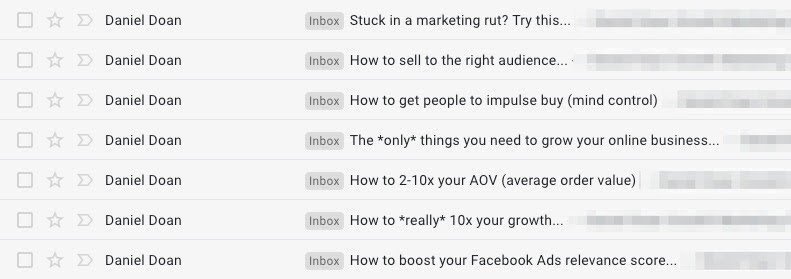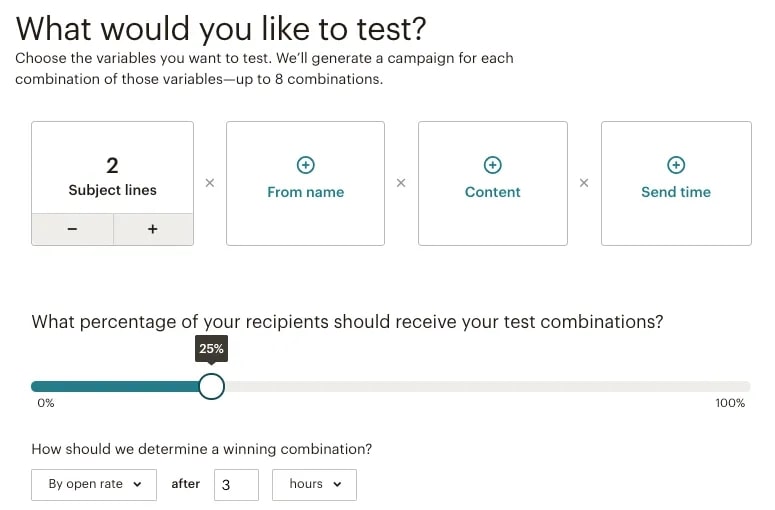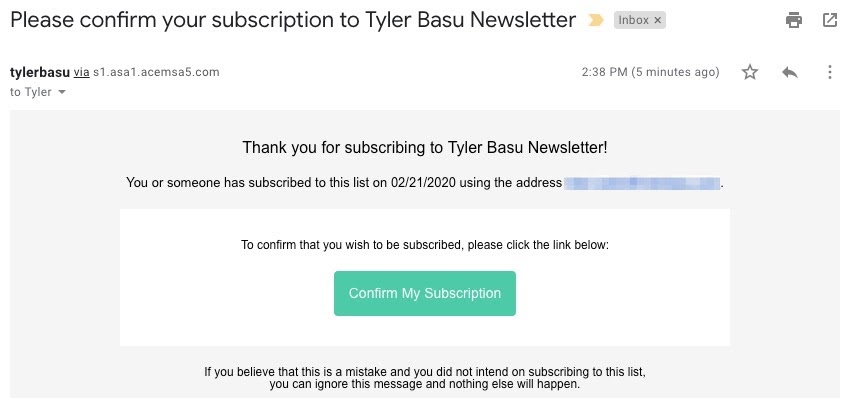The Ultimate Guide To Maximize Email Marketing ROI!
If you’ve been growing an email list for your eCommerce business, you should already know how powerful email marketing can be. Now you’re probably wondering: how can I continue to be successful with my email marketing? To help you address that question, I’ve put together this ultimate guide that contains best practices in email marketing that I will help you maximize your ROI. Let’s jump right into the details!
How to monitor your emails and measure ROI

First, what is email marketing ROI? Return on investment (ROI) is a universal profitability ratio. Email marketing ROI refers to the indicator that evaluates the efficiency of a given investment in your email marketing campaigns, or to compare the effectiveness of several different investments.
If you’re not currently tracking your emails, you won’t be able to monitor key metrics such as opens, click-through rates, and conversions. Without tracking this data, you have no way to evaluate the effectiveness of your email marketing campaigns. If you start monitoring this information, the data will basically tell you exactly what to do or not to do.
If you don’t have a tool to monitor your emails right now, I’d recommend trying HubSpot’s free CRM. You can also acquire deeper knowledge about email marketing by taking their free training courses. There are a lot of great email monitoring software choices to choose from. Most CRMs can show you real-time notifications when your email is opened, enabling you to schedule emails and save email templates.
You’re going to want to use a CRM that has access to rigorous reporting. Being able to monitor opens, clicks, and other targets will help you understand how to optimize your emails for better conversions, as well as test variables for improvement.
Read more:
- 10 Upsell Email Templates That Strongly Convince
- 11 Welcome Email Templates That Always Win Your Customers
- Why should you clean your email list?
- How to master using images on email marketing?
How to maximize email marketing ROI
Start with compelling a subject line
When you’re approached by a press article or an email, what do you look at first? The headline, right? I do so too. Your subject lines are one of the biggest contributors to your open rates. Here are a few ideas to help you write an eye-catching subject line:
Use short subject lines
Try to keep your subject lines short (4-7 words is ideal) and don’t use all caps. Longer subject lines are usually cut off on mobile devices, and excessive use of caps may be viewed as spammy and invasive. If you need inspiration, check out our list of best email subject lines.
Arouse curiosity

Use terms that generate intrigue (without being misleading) instead of directly stating the content of your email. Keep in mind that the purpose of a subject line is to get somebody to open an email, and curiosity helps. Copywriter Daniel Doan does an amazing job with his subject lines. Most of them contain eight words or less and are written to create curiosity.
Use emojis
Experian discovered that 56 percent of brands using emojis in their subject lines had higher open rates. Obviously, using emojis is a perfect way to make your subject lines stand out in a crowded inbox, express a particular emotion, and humanize your brand. Depending on the business and target audience, using emojis can be viewed as unprofessional or off-brand. Assuming they’re not, I suggest that you try them out — just don’t overdo it.

This is an example of a subject line using emojis. This emoji has helped them express the emotion that a customer would feel without using a lot of extra words.
Implement personalization
Emails that include the recipient’s first name in the subject line have higher open rates and click-through rates than emails that do not. That said, adding the name of your subscriber to your subject line is not the only way to customize your email.
If you have any other details about your subscriber (such as their location, industry, interests, etc.), you can further personalize your subject line by adding those details. Here’s an example:

Do split tests

Many email service providers let you do split tests on different versions of your subject line. For example, with Mailchimp, you can test several subject lines for a certain percentage of your list, and then send the winning subject line to the rest of your list after the test is complete.
Pay attention to preview text

Your preview text is a short line of text that appears in an email inbox after the subject line. By default, most inboxes will show the first few lines of text from your email as your preview text. Here are a few tips for writing appealing preview text:
- Do not repeat the subject line
- Keep it short (30-50 characters) to help prevent the text from being cut off.
- Don’t summarize your email.
- Add a call-to-action to encourage recipients to open the email.
Send only relevant content
Email marketing is one of the most successful (and cheapest) ways to distribute your content, so it’s no wonder that 87 percent of B2B content marketers rely on email marketing. With competition for the attention of your market so strong, most consumers have a diminishing tolerance for content that is not important to them. Here are some ways to ensure that your emails are important to your subscribers:
Send content targeted to the needs of your customers. Don’t presume that everyone on your email list has the same interests. Whenever possible, segment your subscribers according to their interests and then only send messages related to those interests.
Use relevant CTAs. If you have several marketing funnels (for various goods and services), be very intentional about the segments of your email list you are promoting to other products or services. If someone has recently downloaded a free case study and the next thing you want them to do is schedule a consultation, do not provide a CTA asking the recipient to consume more materials or download other free tools. Move them forward in the funnel, not backwards.
Segment your email list
One of the biggest mistakes that you can make as an email marketer is to treat everyone on your list equally. To further ensure that your subscribers receive emails based on their preferences or stages in your marketing funnels, you’ll need to segment your list.
Segmentation helps you to deliver the right message to the right person at the right time. And the extra time it takes to segment your email list is certainly worth it. Segmented email campaigns lead to higher open rates, higher click-through rates, as well as lower bounce rates and lower unsubscribe rates.
Segmenting your subscribers on the basis of the website pages they have visited (or not visited) is only one of many ways to segment your list. Here are four ways that most email service providers would allow you to build a section of your list before sending an email:
- Demographics (age, sex, industry, occupation, etc.)
- Place (city, region, country, etc.)
- Interests (preferred content, survey responses, etc.)
- Behavior (web pages, links clicked, transactions made, etc.)
Perfect your welcome email
The first email sent to a new subscriber is probably the most important one. Your welcome email is the starting of what you hope will be a long-term and profitable partnership with your subscriber.
With an average open rate of up to 82%, your welcome email is expected to have a higher open rate than all your other marketing emails. Therefore, it’s important to be intentional about what you put in your welcome email. Here’re a few tips to help you tackle welcome emails:
Set expectations. Reintroduce yourself or your company to new subscribers in your list. Remember why they have opted for your list and let them know what they can anticipate from future emails (such as email topics and frequency).
Start a loop. If you have more emails in your welcome sequence, create anticipation for those emails by letting your subscriber know what you’re going to give them next (more hints, special deals, etc.). Here is an example of how I opened a loop at the end of an email:

Ask for a response. If they have subscribed to your email by asking for a particular resource, ask them to confirm that they have received the resource. If you would like to start a conversation with your subscriber, ask them a particular question and ask them to respond.
Get pre-made welcome email series that is proven to work!
Maintain your list frequently
Many email marketers provide their subscribers with one of two options: 1) to stay on their list and receive all their emails, or 2) to unsubscribe and not receive any emails at all. Giving your subscribers more flexibility over the emails they receive from you, combined with the daily elimination of inactive subscribers (maintenance list), helps retain higher open rates and a better reputation with your email service provider.
Depending on your email service provider, you might be limited in the number of options that your subscribers can control. If possible, there are two things you can consider giving your subscribers control over:
Allow customers to unsubscribe
Not all of your subscribers would want to receive all emails you send. Provide them with the option to subscribe and unsubscribe from various types of emails (new content, promotions, new product updates, customer-only emails, etc.).
Here’s an example of a notice in a promotional email. By clicking on the P.S. section, the recipient can avoid getting emails about the course, but still stay on their list.

This simple technique enabled the sender to segment his email list based on a subscriber’s interests in a particular course, without pressuring those who are not interested to unsubscribe from their list.
Allows customers to decide how often they receive your email
Let your subscribers pick how frequently they get email messages from you (weekly, biweekly, monthly, etc.). A large part of your list is likely to want to keep getting emails from you, but less often.
Check in with your inactive subscribers
Establish a section of your list that has not opened or engaged any of your emails for a particular period of time, and then send them an email asking if they still want to keep receiving emails from you.
Delete inactive subscribers
Removing inactive subscribers from your list on a regular basis is a good way to help maintain healthy open rates on your emails. Because some email service providers bill on a list size basis, pruning your list of inactive subscribers can also help reduce your costs.
Do split tests frequently
Doing split tests on your emails is a perfect way to collect data on what works best with your email list and/or unique segments of your list. Apart from your subject lines, here are a few other elements you can test to help you improve your open rates and click-through your emails:
- Call to action. Check different CTAs, as well as different CTAs for different segments of your email list.
- Design. Try different design options such as formats, fonts, colors, text sizes, etc. to see which design gives you the best results.
- Time. Test different times to send your emails, as well as send emails based on the local time zone of your subscriber (most email service providers let you do this).
Be compliant
Essentially, email marketing is intended to be a permission-based communication platform. In order to create a reliable source of information where our subscribers and consumers want to hear from you, you need to comply with email marketing legislation and best practices. Here are some suggestions to avoid spam complaints from your subscribers:
Double email after opt-in
Don’t allow new subscribers to access your email list without first checking that they would like to receive emails from you. This can be achieved using a opt-in, where your email service provider sends a confirmation email to a new subscriber before you send your first marketing email, such as this one:

GDPR Compliance
GDPR is the name given to a range of EU legislation on the protection of personal data, including the collection and use of email addresses. These laws apply not only to organisations located in the EU, but to everyone who stores and processes data about EU residents.
Without going into too much depth (see this GDPR and email marketing guide for more details), the bottom line is that you need to be able to prove that your subscribers have given you the permission to send them marketing emails.
Unsubscribe links

Don’t make it hard for your subscribers to unsubscribe. Have an easy-to-find unsubscribe link in the header or footer of all your emails.
Be mobile-friendly
With almost half of all emails opened on a mobile device, your emails need to be tailored for mobile devices. Here are tips for sending mobile-friendly emails:
- Mobile, responsive interface. Use a mobile-responsive design that adjusts to varying screen sizes for emails that are not plain text.
- Paragraph size. Don’t use long paragraphs. Break up them into smaller sections, so there’s plenty of white space in your email. It’s easier to read that way.
- Email length. Generally, it’s best to keep your emails short and right to the point. The highest response rates tend to come from emails containing between 50 and 125 words.
- Image size. Large image sizes take longer to load. Most email service providers allow you to adjust the image resolution after you upload the original image file, but not the size of the image file. The world’s most common screen resolution (including smartphone across all platforms) is 360×640. I also suggest that you avoid using photos that might not be legible on a small screen (e.g. infographics with small text).
Be consistent
The never-ending debate among marketers is how much we send emails to our list. Some email their list daily and say that it works well for them, while others refuse to send more than one to two emails a month.
However, one thing we can all agree on is that consistency matters. To stay on top-of-mind with your subscribers, you will need to communicate consistently with them. How much you send an email to your list is completely up to you. There’s no one-size-fits-all frequency that works best for every brand. The easiest way to decide how much you can submit to your list is to test various frequencies and gage the impact it has on your goals (open rates, unsubscribe, sales, etc.).
No matter how much you email your list, remember to concentrate on quality over quantity. Email your subscribers when you have something important and/or useful to share with them. Don’t just send emails to your list for the sake of emailing marketing.
Related posts:
- Marketing Automation for eCommerce
- How Long Should A Cover Letter Be?
- How to Create an Email Signature in Gmail?
- Constant Contact vs Mailchimp
Final words
That’s it! I hope this article has given you valuable insights into how to maximize your email marketing ROI. Please feel free to leave comments below for further discussion on this topic.
Lasty, speaking of email marketing ROI, we have this very functional app named AVADA email marketing that can assist you tremendously with your email marketing. It enables you to track important metrics such as open rates, click-through rates, conversion rates, bounce, unsubscribe, and many more. You can download it for free on the Shopify app store at this link!
New Posts








